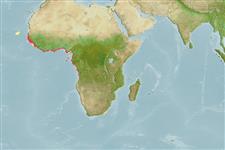Common names from other countries
Environment: milieu / climate zone / depth range / distribution range
Ekologi
; kisaran kedalaman 0 - 30 m (Ref. 436). Tropical
Off West Africa, from the Cape Verde Islands; Senegal to Angola.
Length at first maturity / Size / Weight / umur
Maturity: Lm ? range ? - ? cm Max length : 27.0 cm BL jantan/; (Ref. 417); common length : 20.0 cm BL jantan/; (Ref. 436)
A moderately large to very large stomatopod. Body conspicuously flattened, smooth, lacking ridges or spines except for the tail region; 6th abdominal segment and telson; which is prickly with small bumps or tubercles. Telson with a raised, elongate boss medially, but without a median ridge. Rostral plate broader than long, with a low median crest on its anterior third. Claws very large, often longer than carapace and armed with 10 to 12 sharp spines on the terminal segment. Color: marked with light and dark cross bands (Ref. 436).
Found in shallow water (Ref. 436).
Life cycle and mating behavior
Kematangan | Reproduksi, perkembang biakan | Pemijahan | telur-telur | Fecundity | Larva
Some members of the order Stomatopoda pair for life and some come together only to mate. Males produce sperm ducts rather than spermatophores; females can brood a maximum of 50,000 eggs. Life cycle: Eggs hatch to a planktonic zoea which lasts for 3 months.
rujukan utama
Acuan | Koordinator | mitra
Schneider, W. 1990. (Ref. 417)
Status IUCN Red List (Ref. 130435)
status CITES (Ref. 108899)
Not Evaluated
Not Evaluated
ancaman kepada manusia
Harmless
penggunaan manusia
| FishSource |
Alat, peralatan
Sumber internet
Estimates based on models
keancaman
Low vulnerability (17 of 100).
kategori harga
Unknown.
